
A young Buddhist was walking home when he saw his teacher sitting in a grove. The young man approached the Buddhist master open to any new lessons he must learn that day.
He was not disappointed.
The teacher requested that he pull a small sapling from the ground.
Knowing of his teachers roundabout teaching methods (they’d had an interesting cup of tea the week before), the young man followed the instructions… easily pulling the ankle high shoot from the ground.
The Buddhist master then asked his student to uproot a slightly larger tree, a knee-heigh sapling. With a harder tug, the student made quick work of that tree as well.
The teacher then asked the boy to uproot a more mature tree. One that had time to grow nearly as tall as the young man. When tugging failed, the student found some sticks and rocks to loosen the ground around the tree. After great effort, the young man was finally able to dislodge it.
The master then asked his pupil to pull one final tree from the ground. The teacher pointed to the growth he wanted removed.
The birch tree his teacher had pointed to was easily ten times as tall as the young man. There was no way he could pull the tree from the ground by himself.
After staring at the tree for a few minutes, trying to infer the lesson he might be learning. The student simply said,
“I can’t.”
Happy, healthy and successful people, like the mature tree, have grown deep roots in the important areas of their life. They have, over time and a great number of small actions, built habits that are so fixed, that no one would even try to challenge them. [1]
“Nature does not hurry, yet everything is accomplished.” – Lao Tzu
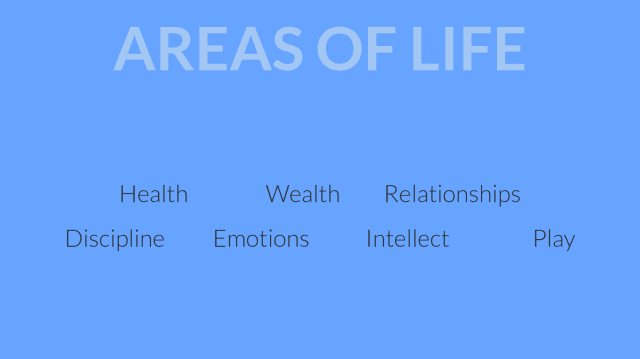
That’s what this article will show you. How to cultivate habits with deep roots.
The process of cultivating deep habits takes time, effort and practice.
However, time is already passing. You’re already devoting effort and practice in various areas of your life. Why wouldn’t you want to do the same – except this time with a bigger pay off?
“You will never change your life until you change something you do daily. The secret of your success is found in your daily routine.” – John C Maxwell
Below are the 5 steps you need to uproot your unhealthy habits and replace them with new ones that, with time and consistency, will allow you to change your life and live like the happiest, healthiest, most successful people out there.
5 Steps to Uprooting Bad Habits and Replacing Them With Powerful New Routines
1. Track Your Triggers
“What we appreciate appreciates.” – Darren Hardy
“We treasure what we measure.” – Roger Hamilton
There are 3 parts to any habit. There is the trigger, the routine and the reward. The three parts together make up the Habit Loop.
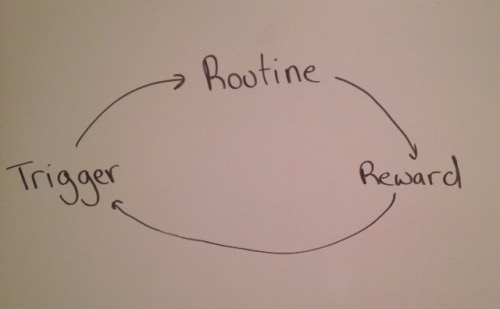
Our strongest habits are powered by cravings that are initiated by “the trigger” and satisfied by “the reward.”[2]
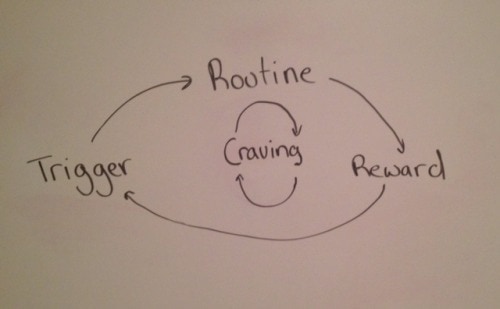
The trigger is what initiates the habit. Your life is full of triggers. For example:
- Your butt hitting the seat of your car is a trigger to fasten your seatbelt.
- Your teeth feeling slightly filmy is a trigger to brush your teeth.
There are also less obvious triggers.
People you spend time with. Places you go. Energy levels. Certain feelings or emotions. A specific time or place can all trigger unconscious behaviors.
Triggers can be found in all areas of your life. That’s why you need to identify them for each unhealthy habit you are trying to uproot so they don’t catch you off guard. It is actually extremely easy to do this. All you have to do is track them.[3]
Tracking can be done by simply jotting down a quick note whenever you feel the urge to hop back on the Habit Loop. The only tools you need are a pen or pencil and a scrap of paper. I like to use a notecards so I don’t loose my tracker as easily.
On the top of the notecard I state what bad habit I am trying to kick. Then I write who, what, where and when on the blank card.
Then I just carry the card around with me in my back pocket. Whenever I notice a trigger, I scribble down a little note. It takes almost no time. This simple exercise will bring a whole new level of awareness to your behavior. Here is what you might find in the four trigger categories:
- Who: Do you smoke cigarettes when you are around certain people? Friends, family members, co-workers?
- What: Is there an emotion that provokes poor eating habits? Stress, anger, nervousness, frustration, boredom, fatigue?
- Where: Are there certain locations that cause you too choose another unhealthy habit? House, car, office, dimly lit places, restaurants or bars?
- When: Are there certain times or physical states that cue your bad habits?[4] – Late at night, while intoxicated, after (long stretches of) work, after lunch, social settings, traveling, before a presentation or performance review, near deadlines?
Tracking My Sweet Tooth
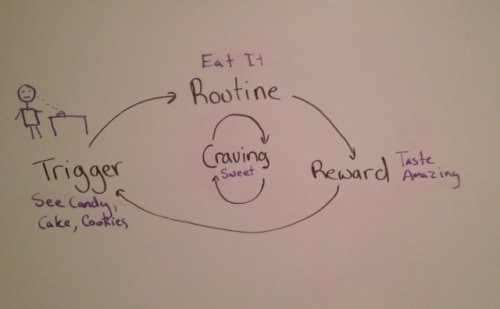
Below is an example “trigger tracker” notecard to a bad habit that I have struggled with for years.
It’s eating too many sweets:
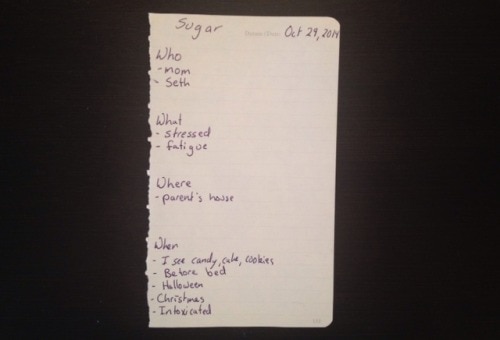
Identification of triggers is half the battle because most poor habits are done unconsciously. Once you’ve tracked your triggers we can use the next step, Scrub and Swap, to clear out most of the poor habits that have grown while you weren’t paying attention.
2) Scrub and Swap
Step one was tracking. Now that you know the triggers to a particular habit, you can do two things:
1. Avoid the triggers.
For me, scrubbing out potential sugar triggers from my life would be:
- Getting all of the sweets out of my house.
- Avoiding my parents house (or asking them to put away the candy dishes when I visit).
- Steering clear of intoxicating substances.
2. Swap the routines.
As mentioned above, habits consist of 3 parts:
1. Triggers
2. Routines
3. Rewards
If you cannot avoid the triggers, you can simply swap the bad routine for a positive (or neutral) routine that offers the same reward. The best example I can think of was when my girlfriend decided she’d had enough of her diet soda habit.

By identifying her triggers she found that it was usually frustration or stress that triggered her unhealthy habit. The tingly effervescence of the soda was the reward that alleviated that frustration and stress.
So, instead of trying to avoid ever being stressed or frustrated again, she simply swapped her soda routine with two healthier routines.
If she felt frustrated (usually at work) she would get up and go for a walk outside where she would perform a few quick stretches. This got her blood flowing and some natural light that would allow her to come back to her work with fresh energy.
If she was feeling stressed, she could do the same walking routine, but she also bought a 12 pack of La Croix sparkling water.
She kept the sparkling water in her office refrigerator, if the trigger for some bubbly reward came about, she could simply reach for the carbonated water that did not contain any of the adverse chemicals found in diet soda.
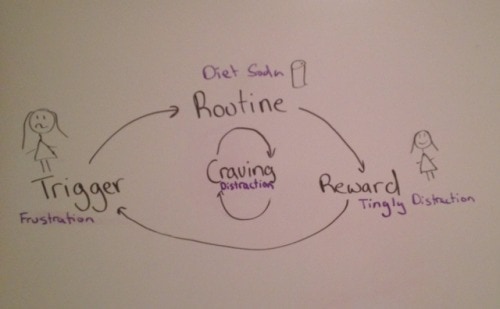
For my late night sweet tooth, I created a chocolate shake recipe that is delicious, healthy and contains no sugar. I also used my same “trigger tracker” to track my routine swaps successes and failures.
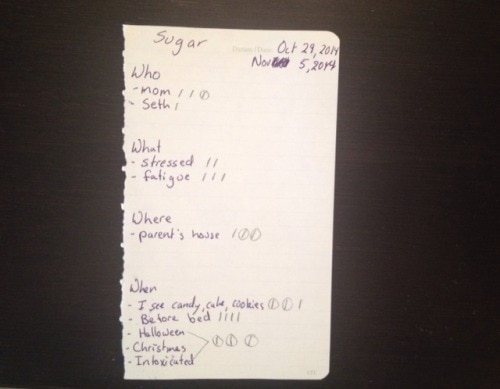
The week of tracking told me I was successful at swapping my routines if my sugar cravings were caused by low energy brought on by stress or fatigue. I used exercise as an alternative routine to candy binges.
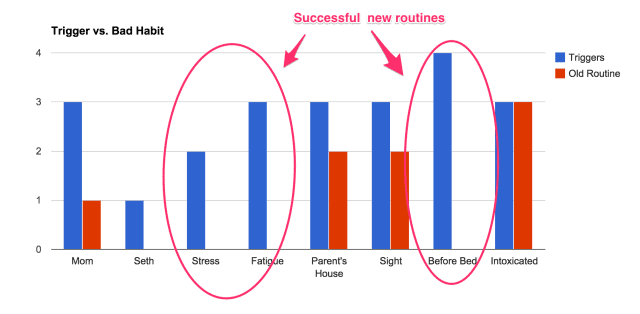
I also was able to avoid most of my daily visual triggers by removing all of the sweets form my home and work environment.
So the only triggers that still need work are in the “outside world.” You can see I struggle when I am intoxicated and when at my parent’s house (where my mom tends to offer tempting desserts).
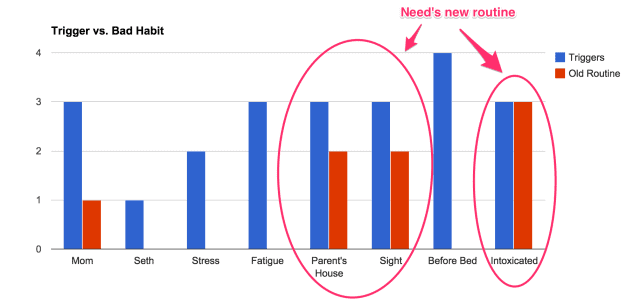
The tracking data shows that I need to create some alternative routines that will satisfy my cravings for sweetness without refined sugar when leaving my “safe” home environment. Trail mix with some dried fruit might will be my next routine swap test.
Tracking, scrubbing and swapping can take care of most of the “early growth” bad habits after a few iterations. However, your Sequoia’s (like my sweet tooth) might need some more powerful excavation tools. The biggest “habit backhoe” out there can be found in step number three: changing your identity.
3) Change Your Identity
Once you have made a choice or taken a stand, you will encounter personal and interpersonal pressures to behave consistently with that commitment. Those pressures will cause you to respond in ways that justify your earlier decisions.[5]
An amazingly sneaky example of this was shown in an experiment that took place in an upscale California neighborhood in the mid-1960’s by social psychologists Freedman and Fraser. [6]
A researcher, posing as a volunteer worker, went door to door asking if the homeowners would be willing to put a large, poorly lettered sign in their yard that read, “DRIVE CAREFULLY.”
Understandably, the request was most often refused. Only 17% said yes.
However, there was another group, in a similarly upscale California neighborhood, that said yes 76% of the time!
What was the reason for the 350% increase in compliance? The difference was a simple “foot-in-the-door” appeal to the test group’s identity. This identity shift was made two weeks earlier when nearly all of sign loving group had agreed to make a small commitment to driver safety by putting up a 3 inch x 3 inch sign in their window.
The request made the homeowners think of themselves as civically minded people who care about driver safety. When asked to do another civically minded act, they acquiesced. At the large cost of their beautifully manicured front lawn, most choose to stay consistent with their new identity and agreed to put the hideous sign in their yard.[7]
The reasons for this (exploitable) consistency are many. For example you may not want to:
- Be thought of as two faced or a “flip flopper” in other people’s eyes
- Admit that an earlier decision might have been a mistake
However, the driving force behind human beings’ strong desire to remain consistent is less obvious. The main reason why you prefer to act consistently is that doing so offers you a mental shortcut.
Let me explain.
Once you’ve made a decision about who you are and where you stand on a particular issue, as long as you stick to it, you no longer have to think much about that issue anymore. You might not put yourself into this “lazy thinker” camp, but the fact is our brains are evolutionarily designed to be cognitive misers. Thinking takes energy. The brain is always looking to save energy wherever it can. Pre-made decisions save energy. Habits also save energy.[8] They both allow you to take action with a minimal amount of thought.
Before you write this off as a weird eccentricity of the human mind, take a second to imagine a world where you need to make a conscious decision about everything you do. Allow me to paint a picture…
You wake up in the morning. What do you do next? Do you get out of bed? What are the pros and cons of doing that? It’s pretty cozy under those covers. Seems like it might be more pleasant to stay here for a bit longer. But maybe there are other things you could be doing.
You could go to the bathroom. Get a drink of water. Get dressed.
After much thought you decide to get out of bed and get dressed. You find some pants in your closet. Now what?
Do you put your pants on one leg at a time or try to jump in both legs at once? Would it be easier if you stood on the bed, pants in hand, and jumped both legs into your pants simultaneously while landing on the floor?
What about shoes? Should you put the left one on first or the right one? Or maybe you should try jamming both feet into your shoes concurrently like you did with your pant legs…
Okay… that got a little silly, but you get my point.
Our lives would be completely overwhelming if you had to think about every decision you make. In this little example, you haven’t even stepped outside yet. Think of all of the decisions you’d have to face just to get to work.
That is why certain habits can skyrocket your life and others can send you down a dark path. Because the unconscious decision making will compound our actions over time. These compounding actions give you your long term results.
Imagine if you thought of yourself as a “health nut.” That is your new identity.
How many tempting decisions could you avoid if you had that identity?
- Do you want some McDonalds? Nope. I’m a “health nut.”
- Fancy a cigarette? Not me. I’m a “health nut.”
- Want to stay up late watching TV? No way. “Health nuts” need plenty of rest.
Or conversely, how many positive decisions would be easier to make?
- Want to pop out of bed and go on a run? You bet. I’m a “health nut.”
There is also additional external pressure identities give you.
- “Were you at the gym yesterday? I thought you were a “health nut?” says your gym buddy.
Your identity is the basis for a huge number of decisions you make everyday. Tweaking your identity is like putting yourself into a super-sized habit loop:
- Trigger: decision about an area of life.
- Routine: reference what “somebody who was like this” would do.
- Reward: reinforce a sense of identity.
The 25 Habits of happy, healthy, successful people listed at the end of this article could all become identities that you put on yourself.
“I am someone who plans” “I am someone who doesn’t take things personally.” Et cetera
However, it would be a mistake to try to change too much of your identity too quickly. That’s why it is important to follow the next step, setting your pace.
4) Set Your Pace
“Motivation is what gets you started. Habit is what keeps you going.”
According to new research, it takes 300 instances of positive reinforcement to turn a new habit into an unconscious practice.[9]
However, there is a shortcut. Awareness.
If you diligently track and focus on a habit for 3 weeks, you have a far better chance of making the habit a lifelong practice. Tracking your habits allows awareness and objective analysis that burns new grooves into your brain at a quicker rate than less attentive action.[10]
So I’ve got a 3 week challenge for you. The first part is to identify the one habit you want to implement. One that supports your most important goals. You can do this by downloading the FREE Habit Tracker 2.0 worksheet at the end of this article.
Print out the sheet and fill it in. The free worksheet and companion video will walk you through all of the steps in the habit loop. The Habit Tracker 2.0 worksheet will take less than 10 minutes and will nearly triple your chances of successfully implementing your new routine.
If you take action, in 21 days you will have a strong new habit that will be growing roots that last a lifetime. These habits will, day-in-day-out, bring your life more significance, security, adventure, connection and progress on your goals.
This proven model will use all of the best techniques covered in this article as well as set the right pace for you.
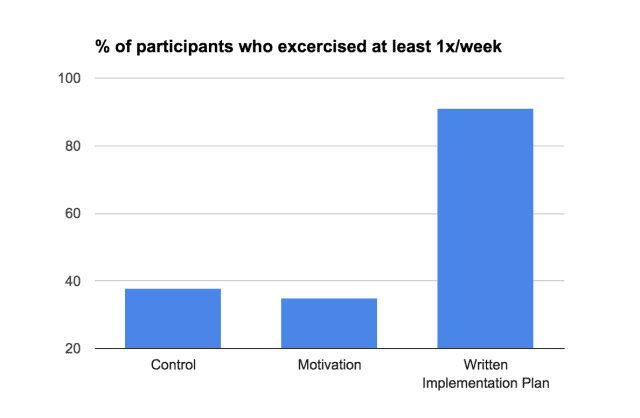
The right pace can be set by both easing in and fully submerging into your new habits.
Ease In
When starting any new change it is important not to do too much too soon. If this article has motivated you to make some major changes in your life, great! I now want to direct that enthusiasm into building habits that will last a lifetime.
It is important that you take heed here.
We want to avoid the common problem of wasting your enthusiasm on unsustainable changes. Change where burnout inevitably sets in within the first week, month or three months. We want something you can sustain. The sum of the little things matter much more than the unsustained heroic efforts.
You need to start where you are.
“Do what you can, with what you have, where you are.” – Teddy Roosevelt
If you were wanting to start a swimming regime for your health, no competent trainer would give you Michael Phelps’ routine and tell you to get paddling.
So when I say ease in I mean two things.
1. Limit the Number of New Habits to One
Do not try to start more than one major habit at a time.
Personal experience has shown me (multiple times) that changing too much too soon is a faulty path to take. The last time I tried the multi-habit approach was about two years ago when I found the Lift App (now called Coach.me).
Lift helps you track the habits you are trying to form. The unique thing about Lift is that you are forming these habits with thousands of other Lift users. They even had a function where people could give you props for your various habit check ins or streaks of check-ins at the time.[11]
This social aspect of the habit tracking app caused me to become a bit ambitious about all of the “healthy habits” I started to implement.
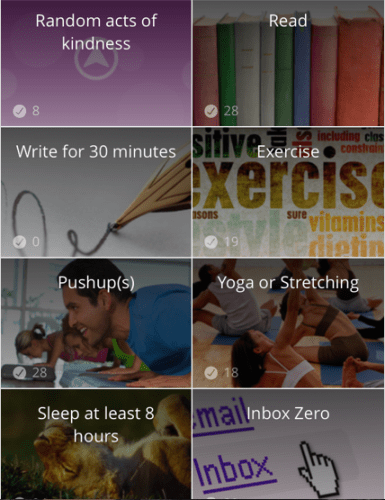
They were:
- Meditate
- Be Grateful for Something or Someone
- Blog More
- Learn Spanish
- Learn to Code
- No Sweets
- Random Acts of Kindness
- Read
- Exercise
- Pushups
- Yoga or Stretching
- Sleep at Least 8 Hours
- Inbox Zero
- Slow-Carb Diet
- Stop Drinking Soda/Pop
- Spend Time Outside
- Wake Up By [6:30]
- Cold Shower
Not only where these 18 habits difficult to remember to implement throughout the day, tracking became a bit of a chore.
The tracking chore was also disheartening. At the end of the day I would see how many habits I missed and feel discouraged.
“Well I ate some candy (failed no sweets and slow-carb) and didn’t take a cold shower, so I guess I only got 15/18. Looks like I’m just a B- habit student.”
It also had the weird effect on trying to implement some of the habits at less than ideal times just so I could get an extra check mark.
“I could be working on my business, but if I read the next chapter, do 15 minutes of Duolingo and 15 minutes of Codecademy, I’ll have half my habits done before 10am.”
I even had some habits that conflicted with each other.
“Damn. It’s 11pm. That means I have to decide if tomorrow I get to check off “Sleep 8 Hours” or “Wake Up By 6:30am.”
After a month or two I had had enough of the regular defeats and weird check in obsession. So I quit everything. The problem was not with the app. The problem was with me and how I approached initiating new habits at the time.
If I had eased in, only trying to do one habit at a time and then focusing on that habit for 21 days before adding a new one, I would have had more success and less negative blow back. For example, I could have started with the great Keystone Habit of exercise. Then I could have noted what I did for exercise that day (yoga, pushups, running, etc) in the habit tracker.
After 3 weeks I could have added the next habit. In this case, I would have chosen mediation. With my exercise habit relatively ingrained, I could hyper focus on a daily mediation practice for a period of time. This focus would have likely solidified my meditation habit a year or so sooner because it wouldn’t have just been one out of many habits that I was trying to add in my life.[12]
2. Be Realistic About The Intensity At Which You Set Your Long Term Habits
Most people will start a new year or a new diet or a new exercise regimen fired up with ambitions goals of losing 50 pounds or eating only salad or making this the year the one were you spend an hour a day working on your side business. However, this is the wrong approach.
What matters most in the beginning is establishing a new routine that you will stick to… even when motivation is low. One way you can do this is by starting with something so easy it seems almost silly to say say no.
Let’s say you are trying to get better at planning. You could start with a habit that says, “Everyday before I leave work, I will write down one thing I want to accomplish tomorrow.” That way, even at the end of a completely draining day, you’re still likely to have enough motivation to write down one task you’d like to tackle the next day.
If you know you are going to try to be an overachiever you may even want to set an upper limit on your new habit. For example, “Everyday before I leave work, I will write down no more than three things I want to accomplish tomorrow.”
Once the routine is set, you can start to escalate the behavior. You can make sure that you are consistently meeting your routine requirements with any number of great habit tracker applications on the market.[14]
Now some of you hot heads out there may say, “Forget this moderation business, Zack. I’m not going to get on American Ninja Warrior with a “moderate” workout routine. I need to be going the the gym an hour a day, 6 days a week!”[15]
I get it. It’s sometimes fun to jump in head first in the shallow end even though the sign clearly states this is not a good idea.

For you “gung-ho” habit havers, I have a sustainability plan I’d like you to enact. I want you to write a clause in you habit contract that says after one month of your high intensity push, you will de-escalate the routine to something you can maintain the rest of your life.
For example,
- After a month of 6 day a week workouts, I will start my long term 3 day a week regimen.
- After a month of 2 hours a day on my side hustle, I will start my long term 45 minute morning effort and take Sunday’s off.
- After a month of daily hour long meditations, I will begin my sustainable 10 minute daily meditation practice.
Fully Submerge
Last summer I spent a couple of weeks in Bozeman, Montana to attend a wedding and enjoy the beautiful surrounding area.
My girlfriend and I stayed with her parents who had a unique ritual of going to their local recreation center and jumping into a cold pool of water before and after they enjoyed the warm, naturally heated thermal pools.
The water was FREEZING. Well… not literally, but 54°s Fahrenheit (12.2°s Celsius) will knock the dang wind out of you.
The only way I could convince myself to go in was by submerging my whole body first thing. Otherwise, the anticipation of the ridiculously cold water would build up in my mind and I wouldn’t do it (and look like a wimp in front of my girlfriend’s relatively macho dad). After a dozen or so excruciating seconds of near-hypothermia, I always found the water refreshing and rejuvenating. My anticipation of getting in the water was actually worse than the reality of just jumping in.
That experience isn’t unlike that of suddenly dropping or changing a bad habit or adding a new one. For a short while it can feel excruciating, or at least quite uncomfortable.
Sometimes wading in just won’t do. Sometimes you really do have to jump in. For the Bozeman cold water pools, the “toe dipping” method would have been much more painful and taken my body much longer to adjust to the new environment.
The idea is to make progress easy, but you still have to show up every single day. And sometimes those first few days suck.
To ensure quick success you must do your best not miss ANY of those first few sessions. You can do this with the idea of no more zero days. No zero days is one of four rules Ryan S from Canada used to pull himself out of a depression and land his dream job.
Rule numero uno – There are no more zero days. What’s a zero day? A zero day is when you don’t do a single f*cking thing towards whatever dream or goal or want or whatever that you got going on. No more zeros. I’m not saying you gotta bust an essay out everyday, that’s not the point. The point I’m trying to make is that you have to make yourself, promise yourself, that the new SYSTEM you live in is a NON-ZERO system. Didn’t do anything all f*cking day and it’s [11:58] PM? Write one sentence. One pushup. Read one page of that chapter. One. Because one is non zero. [16]
Setting your pace is vital to quickly creating sustainable habits.
Remember we are looking for consistency over results in the early stages. Be proud of even your smallest wins. You chose to do something instead of nothing and that’s what will make all of the difference.
Next we’ll cover how to make those habits a bit easier to set by taking advantage of the habits you already have with the “Trigger Stacking” technique.
5) Trigger Stacking
A trigger is what initiates a habit. You already have thousands of triggers which lead to thousands of routines that are vital for getting you through each day.
For example, your brain is probably very efficient at remembering to walk the dog or to brew your morning cup of coffee. You can take advantage of these strong neuro-connections to build new habits.
According to James Clear, my favorite habits expert, trigger (or habit) stacking is the quickest way to build a new habit into your life. [13]
To use habit stacking, just fill out Mr. Clear’s sentence stem:
Before/After [CURRENT HABIT], I will [NEW HABIT].
Here are some examples:
- Reading Habit: Before I eat breakfast, I will read 10 pages.
- Meditation Habit: After I make my bed, I will meditate for 5 minutes
- Journaling Habit: Before I leave work, I will write 3 things I accomplished that day.
- Planning Habit: After dinner on Sunday, I will plan my week.
- Abundance Habit: Before I take my morning shower, I will say one thing I am grateful for that day.
- Push Up Habit: After I brew my morning coffee, I will do 15 pushups.
- Inversion Habit: Before I get dressed, I will do a 15 second handstand.
- Hydration Habit: After I go the the restroom in the morning, I will drink 500mL’s of water.
To get started on trigger stacking, simply write out a list of the current habits that you do each day. Then, write out a second list of the habits you want to start. Finally, pick out one habit and look for an appropriate place to stack it. I’ve made this a part of the Habit Tracker 2.0 worksheet, so be sure to get yours today.
25 Habits of the Happy, Healthy and Successful
“Your daily behavior reveals your deepest beliefs.” – Robin Sharma
“Living your life without a plan is like watching television with someone else holding the remote control.” – Peter Turla
- They Have Morning and Evening Rituals
- Habit: Stretch for 2 minutes
- Habit: Meditate for 5 minutes
- Habit: Write three things you’ve accomplished that day
- They Don’t Try to Hold Everything In Their Head
- Habit: Put ALL to do’s into a task manager
- Habit: Set reminders for tasks you want to do on a certain day (e.g. get haircut on Saturday)
- Habit Put ALL appointments into calendar
- They Read
- Habit: Read 10 pages a day
- Habit: Read 30 minutes a day
- They Live in The Present Moment
- Habit: Start a meditation practice
- Habit: Set reminders to “stay focused”
- They Have a Balanced Diet
- Habit: Eat a salad with one meal a day
- Habit: Drink one “green” smoothie a day
- Habit: Have a high protein breakfast
- They Know Their Core Values (or Morals) and Live In Alignment With Them
- Habit: Read core values daily
- Habit: Re-write core values annually
- Habit: Reference core values with every major decision
- They Exercise
- Habit: Run before work Monday, Wednesday and Friday
- Habit: Go to yoga on Sunday
- Habit: Lift weights three times a week
- They Love What They Do
- Habit: Spend 30 minutes a day working on a marketable skill you enjoy (e.g. writing, public speaking, drawing)
- Habit: Give only two answers when starting new projects. No. Or Hell Yes!
- They Understand That Prevention Is Better Than Treatment
- Habit: Change oil in car every 3,000 miles
- Habit: Make home repairs the week that they are noticed
- Habit: Back up hard drive once a month
- They Take Strategic Risks
- Habit: Do something outside of comfort zone once a week
- Habit: Look for asymmetric risks (massive downside)
- Habit: Act on asymmetric rewards (small downside with huge upside)
- They Are Impeccable With Their Word
- Habit: Tell the whole truth… even when it is difficult
- Habit: Do not speak negatively of self or others
- They Don’t Take Things Personally
- Habit: When hurt, remember nothing others do is because of you
- Habit: Do not retaliate or give “payback” when slighted
- They Make Data Driven Decisions
- Habit: Test everything that is testable
- Habit: Always be testing and asking for feedback
- Habit: Don’t take feedback personally (see habit 12)
- They Don’t Make Assumptions
- Habit: Ask questions if unsure
- Habit: Communicate as clearly as possible to avoid misunderstandings
- They Prioritize
- Habit: Reference long term goals weekly
- Habit: Write down your most important tasks for the day
- Habit: Write down your most important tasks for the week
- They Have An Abundance Mentality
- Habit: Be happy for other’s success
- Habit: See problems as opportunities
- They Plan
- Habit: Break down all big projects into written sub-tasks
- Habit: Decide what done looks like before starting a project
- They Change Plans
- Habit: Throwout sunk costs when evaluating need for new direction
- Habit: Make data driven decisions
- They Get Enough Sleep
- Habit: Set an electronic curfew
- Habit: Set a “in bed by” time
- They Have Written Goals That They Reference Often
- Habit: Re-write annual goals every year
- Habit: Review at annual goals once a week
- They Play
- Habit: Do a handstand or cartwheel everyday
- Habit: Enroll in leagues with organized games (e.g. softball, kickball, soccer)
- They Seek to Understand
- Habit: Listen and ask questions BEFORE defending your position or actions
- Habit: Ask questions if unsure
- They Devote Enough Time To Relationships
- Habit: Call parents weekly
- Habit: Kiss spouse daily
- They Surround Themselves With Great People
- Habit: Do not make ANY plans with people that bring you, your ideas or other people down
- Habit: Look for ways to help the people you aspire to be like
- They Hydrate Their Asses Off!
- Habit: Drink 500mL of water first thing after waking up
- Habit: Make water default beverage at restaurants
- Habit: Bring a bottle to work and fill it up x number of times a day
A Final Note
Change is hard. Tracking, Scrubbing and Swapping, Changing Your Identity, Setting Your Pace and Trigger Stacking will give you an edge… but it’s still hard.
However, is this difficulty a bad thing?
Since change is so hard… most people won’t do it. Since most people won’t do it, it makes it easier for you to stand out from the crowd when you do. If you keep adding a new habit every 21 days you will have 17 new life changing habits by this time next year.
Don’t put if off because you think it will take a lot of time. That time will pass anyway. Make a small change now. That small change, over time, will make a BIG difference.
“A year from now you will wish you had started today.” – Karen Lamb
“What you do today is important because you are exchanging a day of your life for it.” -unknown
Need Some Help?
If you need some support with building habits that can skyrocket your life, we’re here to help! We’ve actually developed our own tracking system to help you identify and track your triggers, routines and rewards. Filling out this tracker will increase your chance of successfully implementing your new habit by 139%.[17]
We’ve packaged it up with more bonus videos and step-by-step how to instructions in our Habit Tracker.
The Habit Tracker includes several valuable resources:
- The Bad Habit Trigger Tracker.
- The New Habit Tracker 2.0.
- A 6 minute video explaining how to eliminate a bad habit and replace it with a new positive habit.
- A 3 minute video on the four most important habits that make the biggest impact on your life.
Just enter your name and email address below and we’ll send it to you:
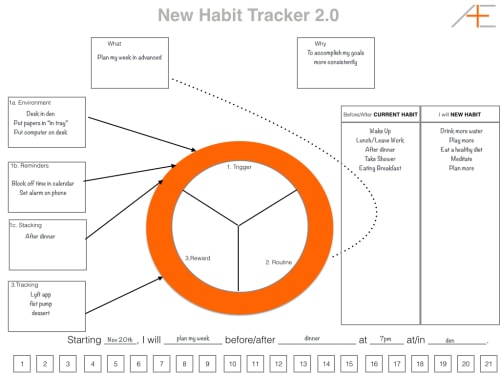
Sources and Notes:
[1] Parable inspired by one found in Darren Hardy’s book The Compound Effect
[2] The Power of Habit by Charles Duhigg
[3] It is easy, but most people will not do it. The first step toward change is awareness. If you are not aware of ALL of your triggers, you will continue to find yourself unconsciously falling back in the old habit loop. The ONLY way to be fully aware of your triggers is by tracking.
[4] That is why certain substances (caffeine and nicotine) are notoriously difficult to quit. These substances give your body not only and emotional craving, but a physical craving to boot!
[5] Influence: The Psychology of Persuasion by Robert Cialdini
[6] Freedman and Fraser Journal of Personality and Social Psychology, 1966. https://psycnet.apa.org/journals/psp/4/2/195/
[7] Fortunately for the beautifully manicured lawns, this was just an experiment. No signs actually went up.
[8] With habits, your brain sees a trigger and goes into a default routine that is stored in the Basil Ganglia. The brain then “wakes” back up to see if the unconscious routine produced the desired reward. The hard wired routines take very little thinking. That’s way you can drive to a location like your office and not remember how you got there. This is a great benefit because you can use your limited thinking energy on other tasks like inventing a spear or launching a rocket into space.
[9] The Compound Effect by Darren Hardy
[10] Or groves, if we want to keep beating my tree analogy into the ground.
[11] This feature has been removed by the developer.
[12] Benjamin Franklin had a similar single tracking approach. Read more here.
[13] Habits Stacking.
[14] Tracker Apps: Lift (has a social element), Full (has goal element)
[15] A secret goal of mine.
[16] Read the rest of Ryan’s life rules and the post that spurred him to share them here.
[17] Implementation intentions: Strong effects of simple plans. https://psycnet.apa.org/journals/amp/54/7/493/




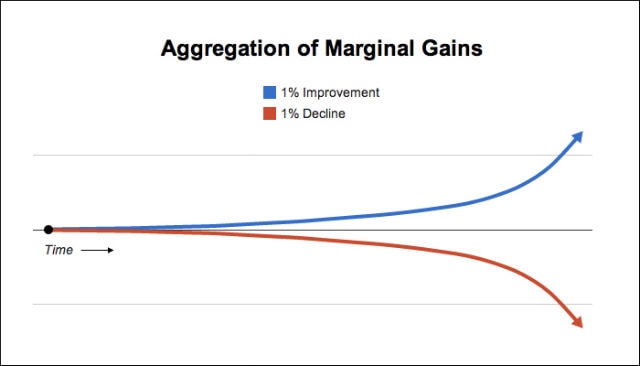



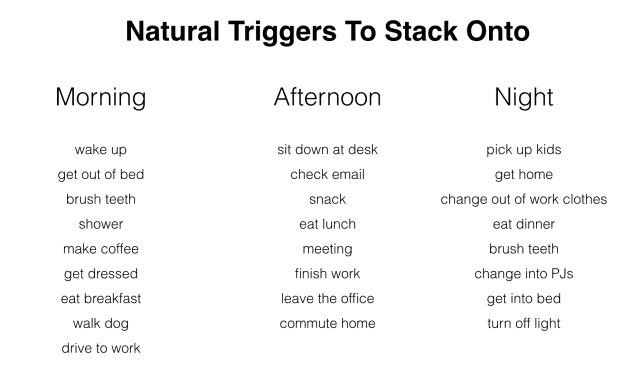

We don’t realize how our health is our wealth until it’s gone unfortunately. Great read!
We all have bad habits and we are oblivious to what some of them are. Mindfulness of how we sabotage ourselves is critical to improving our lives. We are are own worst enemy.
I teach time management professionally and I remind people that you can’t manage time — all you can manage is behavior. Identifying and getting rid of the habits that interfere with good time management is the key. Once you’ve identified the bad habits the next step is to change them. Your article gives one of the best summaries I’ve read on how to do that.
Thank you.
Meditation every early morning give people some ‘power’ to compete task better and absolutely more productive. thank you :)
I am very grateful that Zachary covered the topic of “easing in” when creating new habits. I too find myself in the same situation Zachary mentioned, for i had too many habit that i wanted to create in a short period of time. I will definitely reassess my goals and habits in way that allows me to successfully find my steady rate of progress.
Thank you very kindly Zachary, your article and habit tacker are very much appreciated!
I agree with Jacob. Great instructions to get started with next years plans. Take a couple weeks to go over and over these instructions and plan out our new habits for next year. Thanks Zachary, you hit this one out of the park.
Zachary Sexton: what an excellent acquisition for this blog!
It is one of my favorite posts ever! :)
I’m blushing Antonio. It’s awesome to be part of such a high caliber team. Just trying to pull my weight.
A comprehensive post with a lot of good insights Zachary. The story in the beginning serves as an excellent introduction. Thanks for sharing.
Thanks Arijit. Inspiration came from a similar introduction in Darren Hardy’s Compound Effect. Highly recommended if you are looking for a bit more inspiration to creating the right habits in your life. I was listening to the audio version of the book when I was writing the article.
Wow, this article will take some time to completely digest, but some amazingly helpful items. Great job.